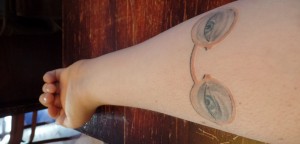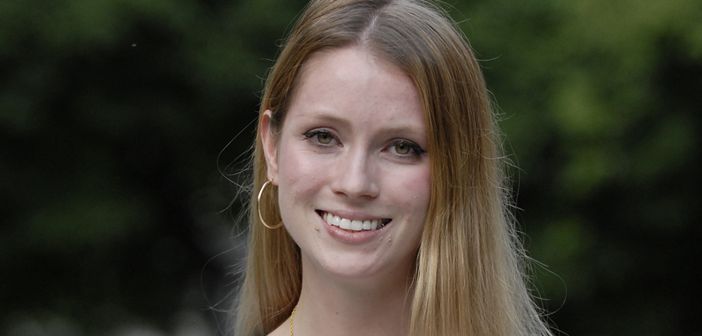Tom Golden, ’18, leans back and searches the ceiling of Hawk’s Nest for the right words to answer my question.
“How would I describe it? Hmm.”
His thoughts now rest on the illustrated skin below his rolled-up sleeve, and he says, slowly, “It’s a pair of eyes. They are blue eyes, with like a yellowish-orange frame — really old frame, looks like it’s from the 30s — and they just look kinda depressed and mysterious, I would say.”
Every once in a while, he says, somebody recognizes those weary eyes peering unexpectedly at them. But “usually, they just think it’s kind of weird. Which it is, because it’s some old guy’s eyes staring at you.”
The unwavering stare was deliberate. It’s the gaze of Dr. T.J. Eckleburg from the pages of “The Great Gatsby,” a novel Tom read for the first time in 11th grade, about a year before he got his tattoo.
“I just felt kind of connected to that character, which is weird because he’s not even a real character — he’s a billboard,” Tom says. “I just kind of looked at him as though he’s the reader, because he’s watching over and observing, and nobody really realizes that he’s there. That’s just how the reader is, watching all the characters. The characters don’t really realize what the consequences of their actions are, but you do as the reader.”
The elusive image of Dr. T.J. Eckleburg has been the subject of academic debate, many concluding that he symbolizes the eyes of God.
Tom interprets the eyes differently, though, saying, “I think in the book, the character Wilson says that these are the eyes of God, judging, and I think the author (F. Scott Fitzgerald) was just kind of saying that’s not true, there’s no God. People just give things meaning so that they feel better, but really it’s just a billboard with eyes there, so I think that’s kind of what he was saying. I find it really interesting, even if it’s depressing, it doesn’t really matter to me.” He adds, “I think it’s just kind of like ironic that I think that’s what he was going for, but it means something to me. So it’s kind of like a paradox.”
Another interesting paradox is that Tom never marks his books, unlike his body. His pristine collection of over a hundred books is arranged neatly on a shelf, all in alphabetical order by author. He began the collection as soon as he started reading as a kid and over the years turned his bedroom into a personal library.
All those stories left an unmatched impression on him. Before deciding on this particular tattoo, he also considered images and quotes from other literature, such as Shakespeare’s “Macbeth”.
“I know people have gotten musical ones or sports teams, and I feel like those things can change —you can change musical taste,” he says. “But for me, I’ve always loved literature, I’ve always loved books, and that’s going to be my major, so I’m planning on that being my career. So I feel like I’ll always read this book, and I’ll always love this book.” With a thoughtful expression, he declares, “Literature tattoos seem to be my thing now.”

Tom Golden stretches out his arm to show his tattoo in Hawk’s Nest on Thursday, Feb. 5, 2015. His tattoo depicts the eyes of the character Dr. T.J. Eckleburg from F.Scott Fitzgerald’s The Great Gatsby. (Kelsey Leck/B&W photo)
The idea of getting this particular tattoo came to him one day while daydreaming during a math class. The concept of the eyes as a tattoo captivated him. Working all summer in the suit department at Macy’s to save up the $150 (plus tip) to pay for his tattoo, he was finally ready.
Just a week before he came to Lehigh, he picked a tattoo parlor, “Tattoo Lou’s”— like “Lou’s Tattoo,” but the other way around —near his home in Holbrook, Long Island. “It was interesting, it wasn’t really what I was expecting,” he said.
The strange experience commenced before he even set foot in Tattoo Lou’s “because I was actually supposed to get it done by somebody else, whose name I don’t remember, but then he like got sick and he just called me the day I was getting it and said, ‘Actually, Jesus is going to give it to you.’ So, I was a little nervous.”
He and his two friends from work left Macy’s in a hurry and drove to the parlor, only to be greeted by ’90s pop music, instead of the hard metal they had expected, and the tattoo artist named Jesus. Two “old ladies” waited for their turn under the gun. With the enthusiastic beat of the pop music and the whirring of the machine, his “posse” eagerly watched as his tattoo took form.
During that hour, despite the parlor’s curious atmosphere, he says, “I felt like a badass or something…I don’t know why I felt so tough, but I did.”
As the interview draws to an end, I ask him if he has plans for more tattoos. Nonchalantly, he replies, “Yeah, I actually might go today.” He says that he and his friend Alex Van Heest, ’18, who looks up and smiles from another booth in Hawk’s Nest, plan on going to the book sale in EW Fairchild-Martindale Library and then a local tattoo parlor. They haven’t yet decided which one.
This time, he wants to get the words, “Passing stranger!” which are the first two words of one of his favorite poems, Walt Whitman’s “To a Stranger.” He printed the words on his typewriter, and that’s exactly how he wants them printed on him.






Comment policy
Comments posted to The Brown and White website are reviewed by a moderator before being approved. Incendiary speech or harassing language, including comments targeted at individuals, may be deemed unacceptable and not published. Spam and other soliciting will also be declined.
The Brown and White also reserves the right to not publish entirely anonymous comments.